Archdean Wenzel Hocke
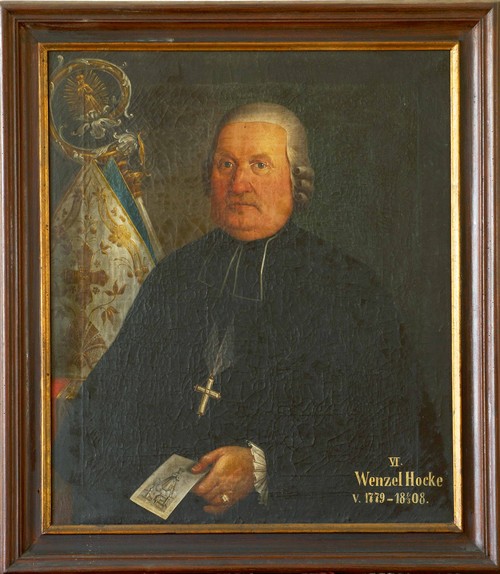
* January 8, 1732, Neustadtl (Jezvé)
† March 1, 1808, Ober Politz
It is not known when Wenzel Hocke was born as there is no record in the parish register pertaining to his birth. The first mention of his name is made on the day of his baptism, which took place January 8, 1732. This date is sometimes referred to as his birthday.
Wenzel Hocke was the firstborn son of Franz Hocke of Neustadtl, miller by trade, and his wife Anna Dorothea Hocke, nee Wäber. His early childhood was spent in Neustadtl, where he also received his primary education at the local school.
In 1798 a conflagration in Neustadtl destroyed the school which was later rebuilt in the same place. The stone building with the house number 2 still stands today and is situated next to the vicarage.
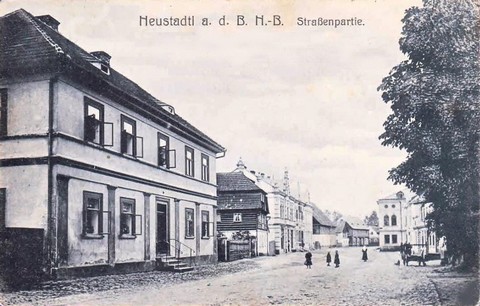
In this school, built in 1798, classes were held until 1900
Since the age of ten Wenzel Hocke attended the grammar school in Bohmisch Leipa (Česká Lípa). He often travelled to school on foot. Later on he was sent to a monastery school in Sagan (present-day Żagań in Poland) before studying theology at a seminary in Leitmeritz (Litoměřice).
Having been ordained as a priest in 1756 he worked as a chaplain in various places. From 1769 to 1779 he held office in Pfarrsprengel Kleinbocken (Malá Bukovina). Thereafter he was posted to Heimsuchung Mariä Church in Ober Politz, where he was appointed Archdean of Ober Politz. In this position he worked for the remainder of his life. He passed away March 1, 1808 in Ober Politz and was buried at the foot of the cemetery cross, which is the place of honour in every cemetery. Sadly, his grave was demolished shortly after World War Two had come to an end.
A memorial to Wenzel Hocke was erected next to the pathway leading up to the church in 1908. The bronze relief of his image was removed and stolen in 1992 but, thanks to the support of the remaining German townsfolk, it was restored in 1997. The sculptor Herbert Hegenbarth crafted the new relief of Hocke’s image and the entire project was funded by Gertrud Lösel.
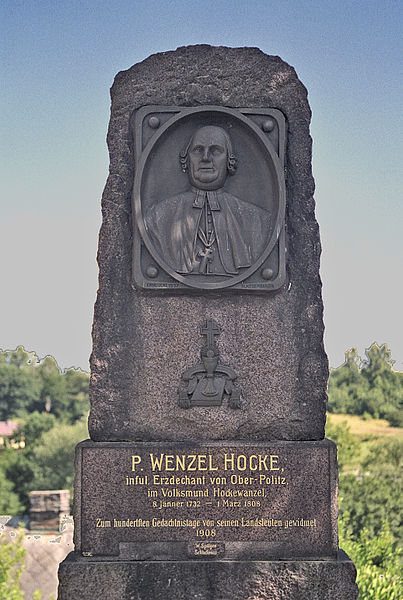
The original memorial in Ober Politz in 1908
Wenzel Hocke, endearingly called ‚Hockewanzel‘, was held in high esteem by both his parish and his contemporaries. Not only did he baptise, marry and bury folk, he was also a man of the people. Hocke frequented restaurants where he would drink beer and play cards with the locals. He would be as funny and brusque as the people he socialised with. His intimate rapport with people manifested itself in his very unique kind of humour. This was soon recognised by his superiors who could do nothing but tolerate it as ‚Hockewanzel‘ was exemplary in fulfilling his duties at work.
After a visitation on September 13, 1795, the entry in the register reads as follows: „The cleanliness and impeccable state of the church, his meticulousness in keeping the church and parish registers, the excellent teaching of the venerable Archdean to his students, his favourable mention by the regional church council, the City Council of Sandau as well as the judge of the archdeanery is incontestable evidence that the venerable Archdean and priest Wenzel Hocke, a man infused with outstanding religious zeal, pursues his calling as shepherd of his parishioners in the most commendable way. He works tirelessly for the advancement of piety and the good in the world which has earned him the full trust of his flock who have been imbued with profound love for the Archdean and who revere him as their eager shepherd and caring father.“
Though assiduous in his duties, Archdean Wenzel Hocke was not averse to indulging in the pleasures of ordinary folk. Having played cards with friends one day he suffered a stroke while returning home in his carriage. This turned Wenzel Hocke into a local hero, the king of Polzental.
For many years to come many a story and anecdote of his life was told and enjoyed by the residents. Stories turned into legends which further added to Hocke’s reputation and fame. These stories were compiled by the Catholic priest Anton Nittel (1826-1902) who first published it anonymously under the title ‚Stories about Hockewanzel‘ in Warnsdorf (Varnsdorf) in 1881. The book met with great interest, went into further editions which were continuously revised, and was even translated into Czech.
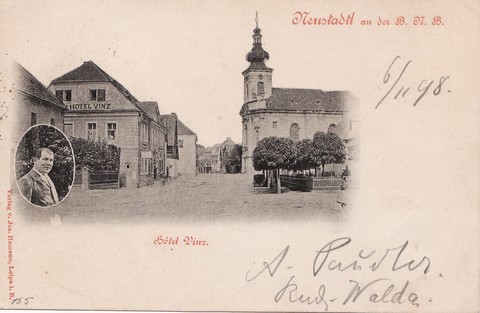
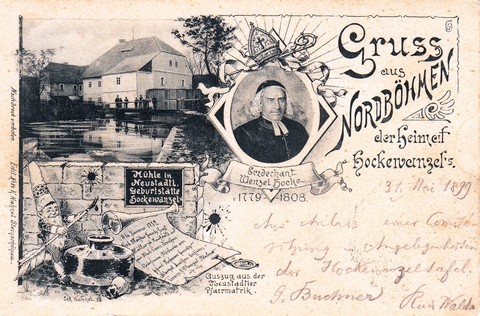
The picture postcard on the left was sent from the meeting of the preparatory committee which took place at the Hotel Winz in Neustadtl, November 6, 1898. It was signed by Professor Paudler and Director Walda and is addressed to the Northern Bohemian Excursion Society of Böhmisch Leipa. The picture postcard on the right dates back to the following meeting of the committee from May 31, 1899, in which Director Walde and committee member Georg Buchner took part
The Northern Bohemian Excursion Society of Böhmisch Leipa concerned itself with researching into the history of the area as well as the lives of local notables and collected relevant information, documents and records. It was the committee member Josef Klein of Leipa who suggested to look into the life of Wenzel Hocke and install a commemorative plaque on the house where he was born. The society’s correspondent, Karl Schreiber, who worked as postmaster in Neustadtl, arranged a meeting between members of the parish council and local merchants. Then and there they agreed upon installing the plaque on the local mill despite the fact that this was not his actual birthplace. This was related by Professor Amand Paudler, another member of the society. Karl Kreibich, the then owner of the mill, was much taken by the idea and promised to look after the plaque like a sanctum. During this meeting a preparatory committee was elected and included Messrs Wenzel Pietschmann, major of Neustadtl; Franz Wöhle, a factory owner; and Karl Schreiber, a postmaster.
The committee commissioned Wenzel Motz, sculptor and architect of Böhmisch Leipa, to craft the 140 cm by 85 cm commemorative plaque which was made of syenite mined in Schluckenau (Šluknov). It carried the following inscription: „In memory of Archdean Wenzel Hocke, known as Hockewanzel, born at Neustadtl, January 8, 1732, died at Ober-Politz, March 1, 1808. Donated by the Parish of Neustadtl, the Northern Bohemian Excursion Society and other admirers in 1899.
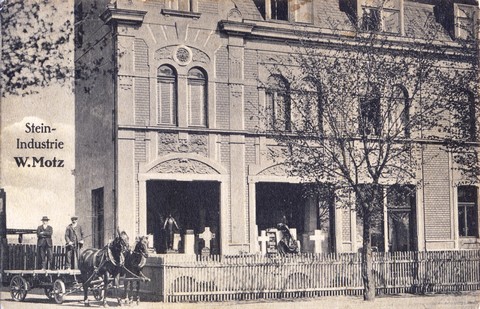
The Wenzel Motz Company – stonemason in Böhmisch Leipa
The plaque was funded by public donations. People could contribute something according to their means.
The Wenzel Motz Company, for example, sourced 105 of the 152 florins needed to finance the project from amongst their staff, friends and business partners.
The plaque was finally unveiled in Neustadtl, June 25, 1899. Numerous people from near and far, amongst them many a famous person, attended the ceremony to pay homage to the great son of the parish. The town was decked out in festive decorations; there were flags and pennants fluttering everywhere. At the mill, where the plaque was to be installed, the organizers had put up the arch of honour.
The inauguration address was held by the president of the Northern Bohemian Excursion Society of Böhmisch Leipa, Director Rudolf Walda: „As with everything deemed worthy by the people which merits being perpetuated, so will the memory of Wenzel Hocke, a man of the people, never fade from our minds. Hockewanzel, who was widely known for his witty, albeit at times earthy humour, deserves to be remembered by means of a visual sign.“
After the memorial had been unveiled, custody of the plaque was symbolically handed over to the parish.
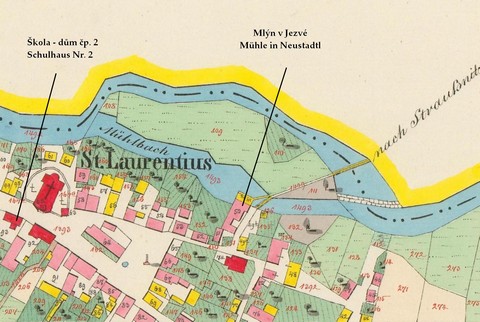
Neustadtl – map of 1842 indicating the original locations of the school and mill
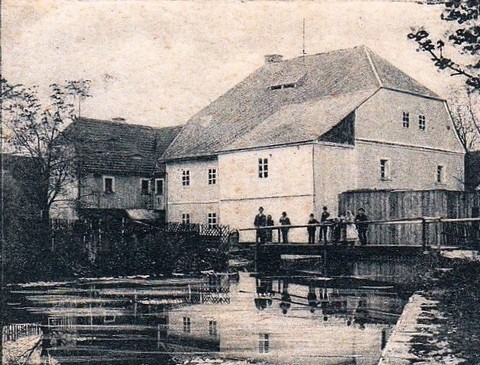
This photograph shows the building of the mill which was built in the same spot where the old wooden mill – Hockewanzel’s birthplace – had burnt down. It was this house that the commemorative plaque was attached to in 1899. To the left of the mill one can see a building that historically belonged to the mill in Neustadtl.
The original mill burnt down in a blaze in 1798, which destroyed most of the houses in the locality. A new mill, as shown on the map from 1843, was built in the same spot. This house, too, doesn’t exist anymore. The current house with the number 53 contains only a fragment of the original stone building which, along with the new commemorative plaque, is all that remains to remember the notable Wenzel Hocke.
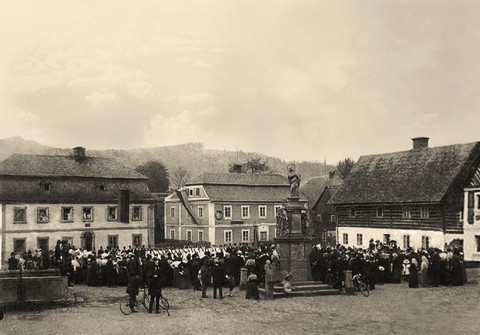
This old photograph, which was found inside the building of the mill, shows the official unveiling of the memorial in 1899
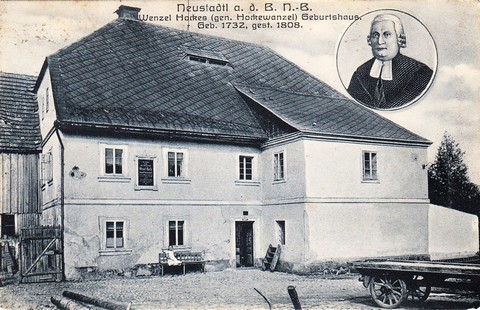
Karl Kreibich´s mill with the original plaque
On 28 June 2020 a meeting was convened in which the following people took place: Wolfgang Hennig, descendant of the Hocke family; Monika Habartová, major of Straußnitz (Stružnice); Petr Zahrádka, representative of the Roman-Catholic parish in Neustadtl; Roman Řezáč, local historian and Petr Fletcher, the initiator of the project. There was full agreement that a new commemorative plaque was to be commissioned and installed.
The plaque was fashioned in same year by the Kamenoprůmyslové závody company in Schluckenau, using the same material that the original plaque was made of, syenite.
The ceremonial unveiling of the plaque took place August 7, 2020, during the Hl. Laurentius pilgrimage. On this occasion P. Stanislav Přibyl, administrator in Ober Politz, Neustadtl und Sandau, blessed the plaque and memorial.
The entire project and the unveiling ceremony were financed by Wolfgang Hennig and the parish of Straußnitz.
The replacement and installation of the commemorative plaque is a homage to Neustadtl’s most renowned son that was a man of the people, who can now proudly remember Hockewanzel as one of their own.
Edited by Petr Fletcher
Translated by Frank Weitzer